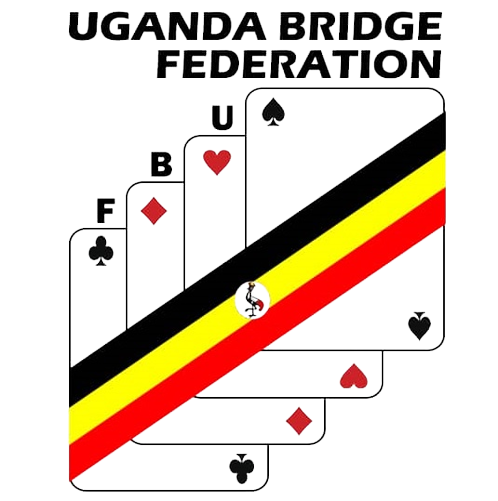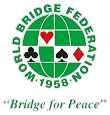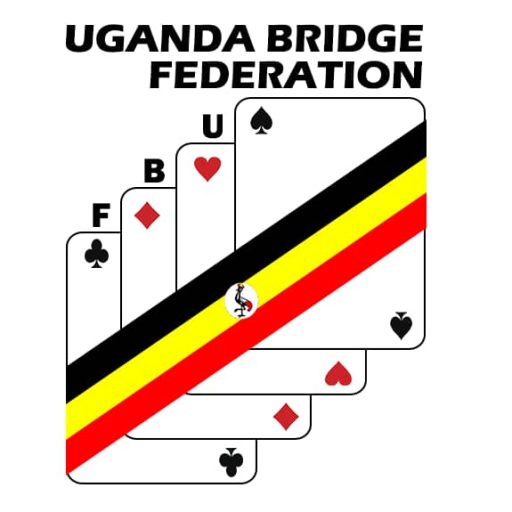Is bridge difficult?
Bridge game rules start out simple but get progressively more complicated. There are several things to consider, such as bridge bidding, scoring, other bridge game rules that might confound beginners or even intermediate players.
Our resources will help you understand not only the rules themselves but also the reasons behind some of the complexities.
What do you need to play bridge?
Once you have decided to learn bridge game, the bare minimum materials you need:
- 4 players
- A 52 cards deck
- A score pad
- Something with which to write
Advanced players, particularly playing duplicate bridge, will also need bidding boxes and “boards”, which are trays into which the cards are inserted.
Bridge rules
As we saw previously, bridge is a card game played with 4 players divided into 2 teams of 2 people each. The players sitting across from each other at the same table form partnerships as North‑South and East‑West.
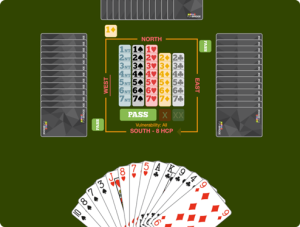
Bridge players position – west, east & North, South
But before getting to the heart of the matter, there is one thing you need to know and that makes bridge different than other card games: the lingo.
The two teams are also called “pairs”.
In a pair, whoever is playing the hand is the “declarer” because that person has declared the “trump suit” or has made the hand to be played without a trump suit, which is called “notrump”.
The “dummy”, which comes from the French word for silent, is the declarer’s partner and places the hand face-up on the table after the “bidding” is done and the “opening lead” is made by the player on declarer’s left.
The other two players are the defenders for that hand. These terms are just a few of the things you will learn during learning bridge.
If you want to know more about these bridge terms, please visit our bridge glossary.
(Or go to our how to play bridge tutorial in our app. When you use our tutorial, how to play bridge will become clearer and clearer as you progress.)
Bridge bidding
A bridge deal consists of two phases: bidding and card play. In this phase, players bid for the minimum number of tricks they think they can take to win the deal.
The dealer makes the first call. He is the “opener”. Then the auction proceeds clockwise. There may be several bidding rounds.
The bidding ends when three players in succession say Pass, meaning that they do not want to bid higher. The final bid becomes the “contract”.
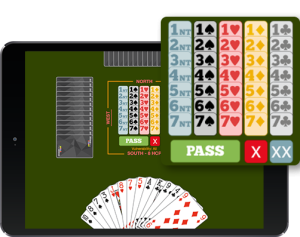
Duplicate bridge bids –
A bid in bridge consists of:
- A number from 1 to 7 called “level”.
- A suit (spades, hearts, diamonds or clubs) or “notrump” (NT).
The number refers to the total number of tricks (six plus the number indicated in the bid) one pair has contracted to make. The suit indicates the trump suit.
For instance, the North-South pair has bid 4H. It commits to making 10 tricks with hearts as trumps.
If a player thinks that the last bid made by one of his opponents is too optimistic, he can double it when it is his turn to speak. This double can be redoubled by an opponent.
The purpose of bidding is to relay information about the strengths and weaknesses of your hand to your partner. It will help you determine the easiest contract to make based on your respective hands. It is therefore important to know the meaning of each bid. This is referred to as “bidding systems and conventions”.
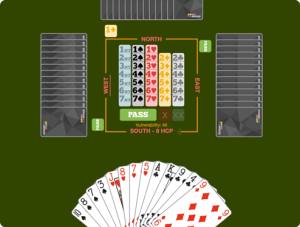
Take a look at the bid decoder now!
Bridge card play
Once the bidding is over, the play begins. Here the aim is to win tricks equal to or greater than the number bid (level).
The players
The “declarer“: the player of the pair who first mentions the suit or notrump that becomes the final contract.
The “dummy“: the declarer’s partner.
The “defence“: the opponent team.
Step 1: the opening lead
The player to the left of the declarer starts the play by making the “opening lead”.
He names the suit and the other players have to play a card in that suit if they have one.
Otherwise they can ruff with a card in the trump suit or discard any other card.
Step 2: the dummy lays out his cards
After the opening lead, the dummy places his 13 cards face-up on the table and his partner calls the cards during the play for both hands.
Step 3: winning tricks
Whoever has played the highest card in the suit wins the trick and leads any card in any suit desired to the next trick.
In a trump contract, if a player doesn’t have a card in the suit led, a trump can be played. In that case, he takes the trick unless a higher trump card is played by someone else.
Step 4: the end of the deal
At the end of the deal, if the declaring pair takes the number of tricks (or more) it committed to in the initial contract, it scores a certain number of points. But if it doesn’t make its contract, the other pair score points.
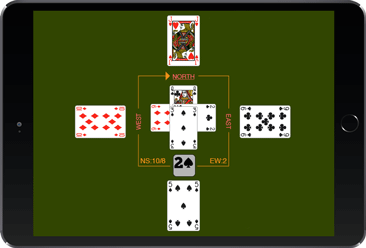
Number of points scored at the end of a bridge deal
Bridge game scoring
An online bridge scoring tool that helps you count points at the end of the bridge deal is available.
Bridge scoring calculator online tool
There are certain guidelines for making bids, and these bids are a form of legal “table talk”. Of course, you can’t say “I have six spades in my hand, so let’s play a spade contract”. You can however bid spades twice to indicate you have six or more of them in your hand.
Our app goes into these guidelines in detail and provides examples of them to check for understanding. It even gets into what are known as pre-emptive bids, which allow you to say “I have six, or even seven, of this suit, so I’d like to play in that suit” legally.
Test my duplicate bridge skills
Additional resources to learn bridge game
Bridge tools
- Bridge score calculator: to help you count points at the end of a bridge deal
- Bridge bid decoder: to help you understand bridge bids
- Bridge glossary: to know every bridge expressions and bridge terms
